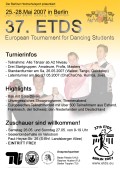ETDS stands for "European Tournament for Dancing Students" and describes tournamens which take place twice a year (at whitsun and in autumn). About 450 participiants come together and compete in latin and ballroom dancing in three breitensport classes and the "open" class for former breitensport members.
The whole event starts on Friday evening with a blind date party (if you want to dance with someone else than your usual partner) and ends on Monday morning with the breakfast. During the event, there are the tournaments, a theme party and a ball with the award ceremony. Usually the participiants sleep in a sports hall. [more...]
Rolls Of Honor
- ETDS podiums (german)
About ETDS
What is an ETDS tournament?
Naming
ETDS stands for "European Tournament for Dancing Students". (However, in Germany, there are other popular but informal interpretations circulating!).
Target group and how to take part in the tournament
Everybody who can dance is allowed to start in this tournament, preferably
students. In any case, each participant is enrolled by the team captain of
his/her university. It's best to be in one of the dance courses offered by
your university. But it's not a "must".
There's a wide range of levels in this breitensport tournament so that
beginners can participate as well as advanced dancers. They will be
organized in different groups sorted out by a qualification round (see
below?) and will not compete against each other. As icing on the cake,
club dancers have their own class ("open class") which is not part of the
breitensport tournament.
All in all, more than 400 students join in the big party around the event of an ETDS tournament which is held twice a year in one of the participating cities/towns throughout Germany or the Netherlands.
Procedure
An ETDS contains 4 single tournaments: 3 breitensport classes (amateurs, professionals and masters) and the "open class", which is open for everyone, club dancers as well as breitensport dancers.
Only the breitensport section has a qualification round which gives each member the opportunity to dance at least two rounds.
Dancers who show a rather weak performance compared to other couples have to dance in the amateur class. Couples who show a brilliant performance (as to other couples) are assigned to the master class. The couples in-between dance in the professional class.
© 2006-2023 Orga-Team Berlin; last modified: 02.02.2016; Author: Stefan Trippler []


